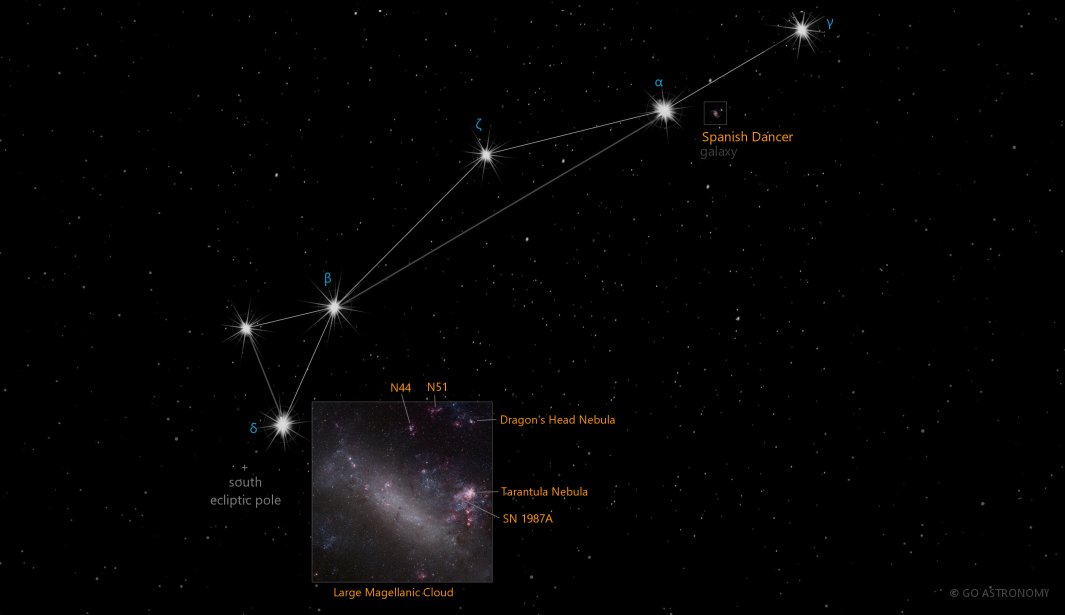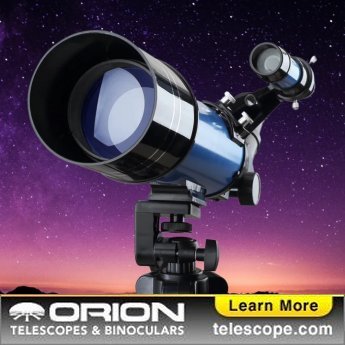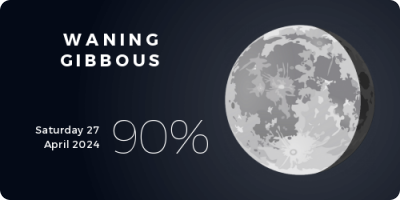Dorado, the Swordfish (Dor)
(duh-RAH-doe)
The Southern constellation of Dorado, the Swordfish, is best viewed in Winter during the month of January.
Dorado is the 72nd largest constellation. It's brightest star is Alpha Doradus at magnitude 3.27. The boundary of the Dorado constellation contains 5 stars that host known exoplanets.
Dorado is a circumpolar constellation, so is visible year-round in the Southern hemisphere. Conversely, it is not visible in the opposite hemisphere.
Red hypergiant WOH G64 is the 2nd largest known star in the universe at 1,600 times the size of the Sun.
- Pronunciation:
- duh-RAH-doe
- Meaning:
- Swordfish
- Genitive:
- Doradus
- Abbreviation:
- Dor
- Constellation Family:
- Bayer
- Hemisphere:
- Southern
- Quadrant:
- SQ1
- Visibility:
- 20° N - 90° S
- Best viewing month*:
- January
- Area:
- 179 sq. degrees
- Size:
- 72nd largest
- Circumpolar** (N=northern, S=southern):
- S circumpolar
- Right Ascension (avg):
- 5h 20m
- Declination (avg):
- -62°
- Brightest star:
- Alpha Doradus (3.27)
- Stars with planets:
- 5
- X-ray stars:
- 14 (7 binaries) stars
- Messier objects:
- |
Brightest Stars in Dorado
The 10 brightest stars in the constellation Dorado by magnitude.
- Star
- Magnitude
- Spectral class
- Alpha Doradus (α Dor)
- 3.3
- A0IIIp (Si)
- Beta Doradus (β Dor)
- 3.76
- F4-G4Ia-II
- Gamma Doradus (γ Dor)
- 4.26
- F0V-F5V
- Delta Doradus (δ Dor)
- 4.34
- A7V
- HD 40409
- 4.65
- K1III/IV
- Zeta Doradus (ζ Dor)
- 4.71
- F7V
- Theta Doradus (θ Dor)
- 4.81
- K2III
- Eta Doradus (η2 Dor)
- 5.01
- M2.5III
- Nu Doradus (ν Dor)
- 5.06
- B8V
- Epsilon Doradus (ε Dor)
- 5.1
- B6V
Star Clusters in Dorado
The most notable and easy-to-find star clusters in the constellation Dorado . Also see all star clusters.
Nebulae in Dorado
Notable and easy-to-find nebulae in the constellation Dorado. Also see all nebulae.
- Nebula name
- Catalog #
- Nebula type
- Bean Nebula
- emission
- Dragon's Head Nebula
- H II region
- Ghost Head Nebula
- H II region
- Tarantula Nebula
- C103
- H II region
- Seagull Nebula (Dor)
- emission
Galaxies in Dorado
The most notable galaxies in the constellation Dorado. Also see all galaxies.
- Name
- Alt name
- Type
- Large Magellanic Cloud
- spiral
- NGC 1553
- lenticular
- NGC 1672
- spiral
- Spanish Dancer
- spiral
Milky Way Satellites in Dorado
Dwarf satellite galaxies that orbit the Milky Way Galaxy located in the constellation Dorado. Also see all Milky Way satellite galaxies.
- Galaxy name
- Alt name
- Magnitude
- Large Magellanic Cloud
- 0.9
Neutron Stars in Dorado
These are the most well-known neutron stars in the constellation Dorado. Although neutron stars cannot be seen in any amateur telescope, they are at the center of many supernova remnant nebulae, which can be seen. Also see all neutron stars.
The Swordfish Constellation
Dorado, also known as the Goldfish or Swordfish constellation, is a fascinating constellation situated in the southern sky. It is a relatively small constellation, but it is of great importance to astronomers due to the remarkable celestial objects it hosts, including the Large Magellanic Cloud and several other notable deep sky objects.
Historical Background
Dorado is not included in the 48 constellations listed by the 2nd-century Greek astronomer Ptolemy. Instead, it was introduced in the late 16th century by Dutch astronomer Petrus Plancius. The constellation was later included in Johann Bayer's star atlas, Uranometria, and has been recognized as one of the 88 modern constellations by the International Astronomical Union.
The name Dorado is derived from the Portuguese 'dourado', meaning 'golden', and the constellation is often represented as a goldfish or a swordfish in celestial maps.
Main Features and Location
Dorado is located in the first quadrant of the Southern Hemisphere (SQ1) and can be seen at latitudes between +20? and -90?. Despite its relatively small size, ranking 72nd in size among the 88 recognized constellations, Dorado is notable for its high density of significant celestial objects.
The constellation Dorado does not have any stars brighter than magnitude 3.00 or located within 10 parsecs (32.6 light years) of Earth. Its brightest star is Alpha Doradus, a binary star approximately 169 light-years from the Sun.
Significant Stars
Alpha Doradus is a binary star system and the brightest star in Dorado. The system is made up of two stars similar in brightness that orbit each other every 12 years.
Another significant star in the constellation is Beta Doradus, the second-brightest star in the constellation. Beta Doradus is a Cepheid variable star and is one of the most luminous stars known in this category. The brightness of this star varies over a period of 9.942 days.
Deep Sky Objects
Without a doubt, the most prominent feature of Dorado is the Large Magellanic Cloud (LMC), one of our closest galactic neighbors. The LMC is a barred spiral galaxy located approximately 163,000 light-years away. It is the third closest galaxy to the Milky Way and easily visible to the naked eye in the southern hemisphere.
The constellation is also home to the South Ecliptic Pole, around which the southern sky appears to rotate. In addition, it contains several notable deep sky objects, including the NGC 1566, an intermediate spiral galaxy, and the Dorado Group (or NGC 1566 group), which is the richest galaxy group of the southern hemisphere.
Observation
From a viewing perspective, the constellation is best visible in the southern hemisphere during the summer months. Observers in the northern hemisphere can see Dorado low on the southern horizon in early winter.
The lack of particularly bright stars in Dorado might make it less obvious to the unaided eye, but the constellation is worth observing for its extraordinary host of deep sky objects. Amateur astronomers equipped with a small telescope will particularly enjoy the views of the Large Magellanic Cloud and other deep sky objects located within Dorado's boundaries.
* Constellation shown for northen hemisphere skies. For the southern hemisphere, constellations appear rotated 180 degrees (upside-down and left-right reversed) from what is shown. Remember that seasons are reversed too - summer in northern latitudes is winter in southern latitudes.
** Circumpolar constellations are visible year-round in the hemisphere listed (and not at all in the opposite hemisphere).





